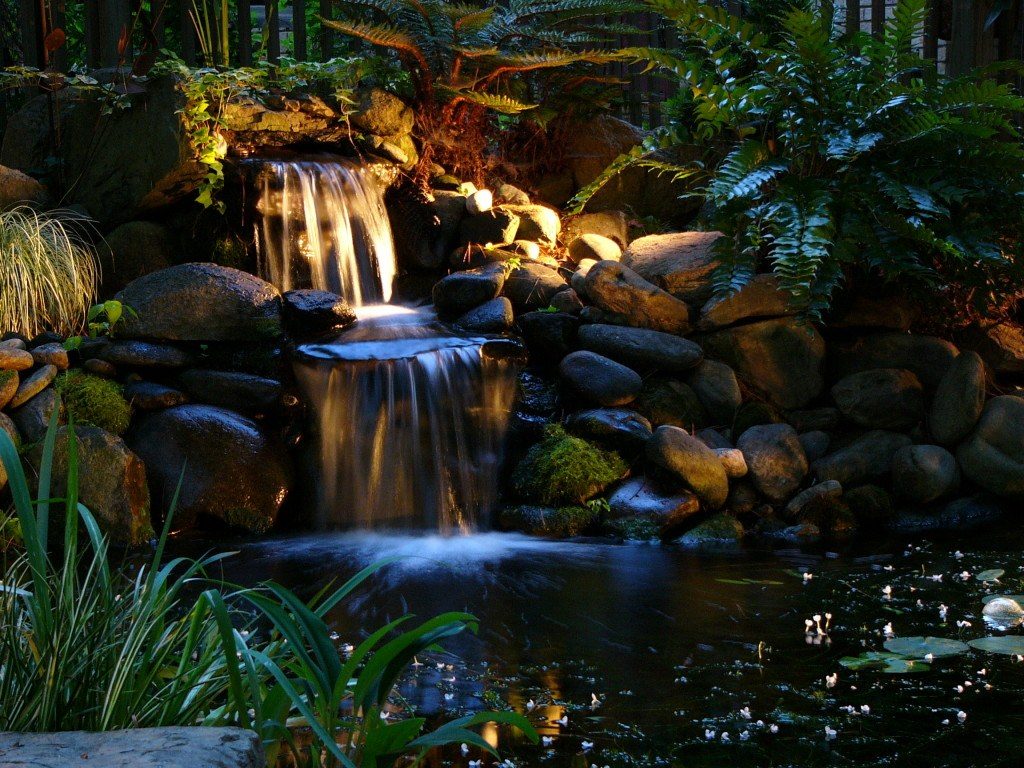Landscape lighting not only improves both the visibility of a walkway and the security of your home, it also creates a beautiful enhancement for your landscaping and the architecture of your home. Low voltage lighting on pathways can add luminous, warm spots of light that emphasize and define the walkway and garden areas, and a well-placed uplight can illuminate the home’s architecture.
When deciding on the type of lighting you want, you have a choice between line voltage and low voltage lighting. There are several advantages of exterior low voltage lighting as compared to line voltage lighting, one being it is easy to install for a do-it-yourself project. At Carolina Outdoor Lighting, we have a great deal of experience in the placement and installation of low voltage lighting. Our designs can have a huge impact on the ambiance of your home and yard. In this article, we want to look at the advantages of using low voltage lighting for the exterior of your home.
Main Differences in Low Voltage Lighting and Line Voltage Lighting
Low voltage and line voltage lighting may sound similar, but there are a few big differences between the two. Line voltage path lights use thick cable that has to be buried 18 inches underground. The cable for line voltage must be run through conduits. And, line voltage needs junction boxes that are weather-tight. Working with line voltage lighting gets the job done, but is not well-suited for staying on all night and energy efficiency. On the other hand, low voltage lighting uses much smaller cables that only have to be a few inches below ground and are much easier to install, making it a simpler process. Let’s look at some details about low voltage lighting.
Components of Low Voltage Lighting
Low voltage lighting has three main components and another optional one:
- Transformer
- Cable
- Lights
- Timer and Photocell (optional)
Transformer
The main component for distributing safe voltage is the transformer. The transformer is a waterproof box that plugs into the outdoor GFCI outlet and the cable is attached to the back of the transformer at a terminal. A transformer converts 120V (high voltage) from the outlet to 12V (low voltage) for the lighting system.
When choosing the appropriate transformer for your exterior lighting system, Carolina Outdoor Lighting will help you choose one that has more power (watts) than the total watts your fixtures use, but not a great deal more. For instance, if you have landscape lights equaling 300 watts, let’s say six 50-watt pathway lights, you would select a transformer that is rated for 400 or 500 watts. You do not want to get a transformer with too much power, such as a 600-watt transformer for the 300 watts because your voltage can become too high exiting the transformer’s components and could overheat and fail.
Cable (Wiring)
The cable (wiring) attached to the transformer will run through your property, finishing at the endpoint of the light run. This wire is usually 50 to 75 feet, approximately the thickness of a lamp cord, and dark-colored. Carolina Outdoor Lighting Professionals will always run the wire deep enough in grass and along sidewalks/driveways so that you can still edge and aerate (about 7-8 inches) and usually close to 3-5 inches in natural areas sod stapled down so that you can find the wire when doing new plantings. There is no threat of shock because it is low voltage. Each light fixture attaches to the wire. The thickness of the cable helps to maintain the brightness of all the lights. In order to achieve uniform lighting and allow for expansion, it is best to use 10 to 12-gauge wire for the main runs.
Lights
Lights attach at any place along the cable using either a push-pierce type of connector or by manually hard-wiring. Carolina Outdoor Lighting Pros hard wires all of our connections because it is much more reliable long term compared to “quick connects.” With low voltage lighting, you can put different types of fixtures along the same transformer line. Anything from patio wall lights to walkway lights can be on the same wire. You must calculate the wattage on the line based on each bulb’s watts so the power rating doesn’t exceed the transformer’s ability. For example, you would not put four 200-watt bulbs on a 600-watt rated transformer because your lights will not work at all.
Timer and Photocell
Attaching a timer or photocell to the transformer saves electricity costs and automates the lighting. Using a photocell causes the lights to come on at sunset and go off at sunrise, while using a timer sets a specific time for the lights to come on and go off. Photocells react to the ambient light and turn on the system when the sun sets. These accessories use a switching system to only provide power when it is needed, thus saving energy.
Advantages of and Reasons to Use Low Voltage Lighting
One of the primary advantages of a low-voltage lighting system is that it is energy efficient. Additionally, if you use LED landscape style lights, the bulbs last much longer than any other type of common light bulbs like incandescent or halogen equivalent lights.
Here are some other advantages for using 12-volt lights for landscaping:
Safer Option
A low voltage lighting system is completely safe, meaning you don’t have to worry about children and pets being in danger around the lights and wires.
Bright Light
The actual light output from a 12-volt system is exactly the same as with 120-volts. You won’t sacrifice the brightness by using low voltage.
Easy Adjustments
Low voltage lighting is easy to change if you don’t want to be locked into one look.
Energy efficient
Low voltage lights are highly energy efficient as compared to incandescent bulbs. Using LED lights, you get a higher quality amount of light output while using only 20 percent of the energy.
Cost saving
You get cost savings because these lights consume less energy, last longer, and provide superior illumination.
Contact Carolina Outdoor Lighting Professionals for Low Voltage Lighting Options
At Carolina Outdoor Lighting Professionals, we are experienced at selecting the best options to enhance your home using low-voltage lighting. We would love to help you make your landscaping and home beautifully illuminated, safe, and secure. Contact us at (919) 523-0561 or request a free evening outdoor lighting demo. We look forward to hearing from you.

